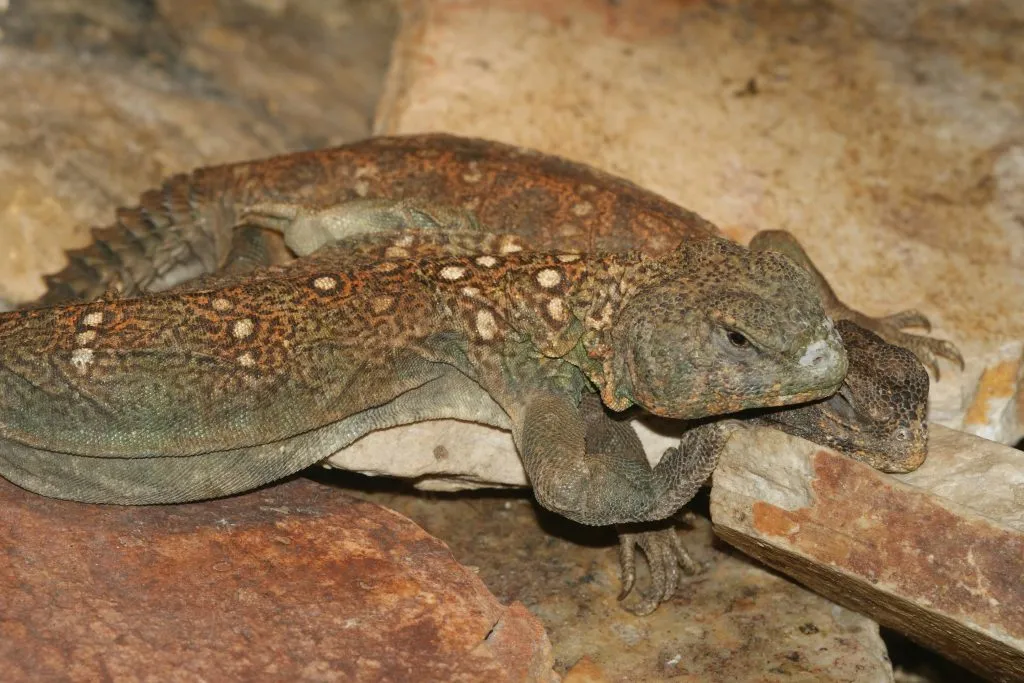
Uromastyx and Bearded Dragons are both captivating lizards that are very popular among reptile enthusiasts. Due to a few shared characteristics, some people think that they can be housed together. Are you curious about keeping uromastyx and bearded dragons together?
Uromastyx and bearded dragons cannot live together due to their major differences in behavior, habitat requirements, and diet. There is also a risk of disease transmission between the two species. Uromastyx and bearded dragons are thus better kept in separate enclosures.
Although it might appear like a good idea to cohabitate reptiles to save space and money, be aware that it will be at the cost of your pets’ health and well-being. If you are not yet fully convinced, read on further to understand why uromastyx and bearded dragons make incompatible cagemates.
Reasons Why Bearded Dragons Can’t Live With Uromastyx

The Size Difference is Dangerous
Uromastyx and bearded dragons are physically distinct from each other. The adult size of uromastyx falls between 10 to 30 inches, while their body weight ranges from 125 to 1000 grams depending on the species.
Bearded dragons, on the other hand, can grow up to 18 to 22 inches in length and weigh anywhere from 285 to 510 grams.
It is also interesting to note that uromastyx are generally slow growers, while bearded dragons can quickly grow to their adult size.
Eventually, one easily becomes larger than the other, and the difference in size can be dangerous especially when they fight for dominance.
They Are Both Territorial Creatures
Uromastyx and bearded dragons are both territorial animals, especially males. They can become aggressive towards each other if housed together.
In fact, male animals of the same species are also discouraged from being housed together.
Both animals can pack a powerful bite when threatened. Uromastyx have thick, powerful, spiny tails and bearded dragons have sharp claws that can cause serious injury.
Serious trauma and injury can arise from dominance fights.
They Have Different Habitat Requirements

Uromastyx and bearded dragons originate from different environments and have distinct POTZ (preferred optimum temperature zones), the temperature at which an animal functions optimally.
Uromastyx are native to hot and dry desert regions of North Africa and the Middle East. They spend most of their time in burrows or rocky areas.
In contrast, bearded dragons are found in a range of dry areas in Australia, including woodlands, grasslands, and deserts. They are semi-arboreal and like hanging out around tree branches.
Because of these differences, the habitat requirements of these two species in captivity also vary.
Uromastyx thrive in a hotter and drier environment, while bearded dragons are suited to warm temperatures but not as hot as what uromastyx need.
| Characteristics | Uromastyx | Bearded Dragon |
| Adult body length and weight *May vary among species | 10-30 inches (30-76 cm) 125 – 1000+ g (<1-3 lbs) | 18 – 22 inches (45-56 cm) 285 – 510 g (10-18 oz) |
| Ideal temperature | Basking: 100-115°F (43-46°C) Daytime: 90°F and up (32-37°C) Night time: 70°F and up (21-26°C) | Basking: 90-95°F (32-35°C) Daytime: 80°F and up (27°C) Night time: 70°F and up (21°C) |
| Humidity | 15-30% | 20-30% |
| Diet | Primarily herbivorous | Insectivorous |
| Is group housing same species possible? | 2-3 females and 1-2 males can be done, but territorial aggression may be a problem. | Males are best housed alone, or with 2-3 females. Beware of territorial aggression. |
The ideal basking temperature of uromastyx is at least 5°F hotter than the ideal basking temperature of bearded dragons, and they require dry substrate, such as sand or gravel, to maintain low humidity levels.
Bearded dragons are prone to ingest loose particles like sand that can cause digestive impaction.
Bearded dragons prefer more humidity in their burrows and hiding places, but uromastyx are prone to skin problems such as tail rot when the environmental humidity is too high.
Clearly, what works for one species can actually be harmful to the other.
They Have Different Diets
Uromastyx and bearded dragons have different dietary requirements. Most adult uromastyx species are herbivorous and their diet should mainly consist of plant matter.
They thrive on a high-fiber diet that includes a variety of fresh vegetables such as dandelion, collard greens, and beans.
Bearded Dragons are omnivores and they require a more varied diet that includes both plant and insect matter. In addition to leafy greens, they like to be fed insects such as crickets and mealworms.
The difference in dietary needs will make feeding sessions tricky when uromastyx and bearded dragons live in a common enclosure.
The uromastyx that is not used to live prey
They Become More Prone to Disease Transmission

Housing two different reptile species together also spells trouble for hygiene and health. Cohabitating means increasing the risk of disease spreading among your lizards.
Snake mites, for example, can transfer from one animal to another, as well as parasites, protozoa, and fungi.
Even when both uromastyx and bearded dragons appear healthy, one could be carrying a strain of bacteria that could be harmful to the other.
A specific strain, Devriesea agamarum, can be found in healthy bearded dragons, but this same pathogen is known to cause disease in uromastyx.
Serious about keeping uromastyx or bearded dragons as pets? Reading more about them in our beardie care guide and in our uromastyx care guide.
Is Group Housing Still Possible?
When the disadvantages clearly outweigh the benefits, it is safe to say that cohabitating uromastyx and bearded dragons are simply a no-go.
You might ask, then, whether group housing the same species of either lizard is ideal?
Typically, females are less aggressive and can be housed together in groups of usually two or three. Males, however, should be housed alone or with a few females if you are knowledgeable and interested in breeding them.
- Enchi Ball Python: A Unique and Stunning Morph of Python regius - March 27, 2025
- Emerald Tree Monitor: The Enigmatic Green Guardian of the Rainforest - March 26, 2025
- The Egyptian Cobra (Naja haje): A Fascinating Serpent - March 25, 2025
